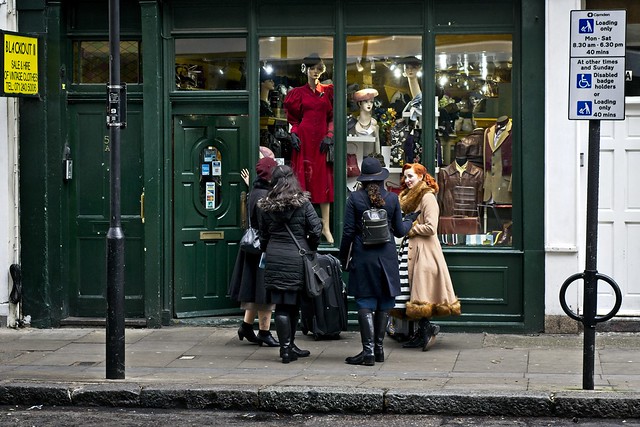Unlock the Magic in Your Story Now
Get the Free 20 questions to Ask Before Launching Your Idea workbook when you sign up for occasional updates.
Get the Free 20 questions to Ask Before Launching Your Idea workbook when you sign up for occasional updates.
Articles filed in: Marketing
Persuade On Purpose, With Purpose
filed in Marketing, Story Skills, Strategy

When you were three years old, you knew exactly what to say, and how to say it, to get what you wanted. But somewhere along the line, you became reluctant to use these skills. We all did.
Stories of con men and unscrupulous marketers, manipulating people into doing things that were not in their best interests coloured our judgement about what it meant to be persuasive. Our culture taught us that persuasion was a trick used by people with dishonourable intentions.
But manipulation isn’t a necessary by-product of persuasion. Being persuasive can be a valuable skill used to impact the people we serve. Like any tool or skill, its effect depends on how it’s used. Our intentions matter. An axe can either build something or destroy it, and persuasion can be as much a force for good, as for bad.
If we’re in the business of making things that change people’s lives for the better, we must master the art of persuasion to help people make decisions they’re glad about.
Instead of wondering how we can convince people to buy our product or support our idea, we could ask ourselves what’s at stake for them if they don’t. Then we can be more persuasive on purpose, with purpose and our heads held high.
Image by Annie Sprat
The Value Conversation

Value is our subjective judgement about the utility, worth or desirability of goods, services or experiences.
It’s the story we each believe about the significance of something.
The value conversation is how we prioritise the allocation of finite resources.
The story we tell ourselves about the cost of gains over losses.
What’s the value conversation your customer is having?
Image by Mark Zamora
Say It With Intention

Communication is not simply an exchange of information.
We’re never just speaking or writing to be heard.
We’re always trying to make ourselves understood.
Before you make the call, deliver your speech or write that email, think about what you want the recipient to know and how you want her to feel.
Then speak or type with that intention.
Because how the recipient feels, not only what she thinks, determines what she does next.
Image by Michael Brace
Reverse Marketing

It seems like the most logical thing in the world to build your marketing strategy around the kind of customer you want to attract.
It stands to reason that you can tell a more resonant story when you know who you’re talking to. But when you’re faced with a market of everyone, it can be difficult to pinpoint your ideal customer. An easier place to start is by considering who you’re not for. Who is the antithesis of your ideal customer?
Who wouldn’t dream of buying your product or service, and why?
What’s the message you’d share to convince that person never to buy from you?
When you can tell that story well, you’ll be something to someone.
*Need help getting clear on your ideal customer so your marketing messages resonate?
The Story Strategy Course is for you.
Image by Todd Gross
Rethinking Customer Loyalty

We’re very good at measuring customer loyalty.
We can track how much a customer spends and how often. We know how long they have been with us and have a plan for retaining them. We create premium memberships, gold cards, reward programs and ego boosting voicemails.
And yet, we often overlook one important fact.
Loyalty is reciprocal. It’s a two-way street.
Even in the age of customer empowerment, an unprofessional dentist will overtreat a patient to boost revenue. An insurer will cancel the cover of a client who’s paid tens of thousands in premiums if a single payment is missed. A bank will close a local branch used by elderly customers, who don’t bank online, to cut costs.
If we’re eager to measure how loyal customers are to us, why aren’t we so keen to measure how loyal we are to them?
Maybe it’s time for a rethink?
What if instead of only measuring, rewarding and expecting loyalty, we started measuring how we demonstrate it?
Image by Todd Gross
What’s The Story The Customer Is Telling Himself?
filed in Marketing, Storytelling

For a long time, our family’s favourite salt came in either 125g or 250g boxes. Last week I noticed the supermarket now stocks it in a 55g refillable mill. It’s the same product in different packaging—except for the price that is. It costs 37 cents per 10g when you buy the salt boxed, and $1.45 for 10g when you buy it in the mill.
Most people would argue that nobody in their right mind will pay almost four times as much for the same product in different packaging. And yet they do. We do! All the time.
We pay more money for convenience and status. We go out of our way to buy products that align with our sense of identity. We place just as much value, if not more, on how something feels than on how well it works.
Often, the key question when it comes to pricing and value isn’t how much is it worth, or what will people pay. It’s, what’s the story the customer is telling himself about what the product is worth to him, and why?
Once we know that, we’ll tell a better story.
Image by Aaron Thomas
The Forgotten Purpose Of Marketing
filed in Marketing, Storytelling

We tend to think of marketing as the way we promote and sell our services. Marketing is partly what we do to take a potential customer on a journey from awareness to a sale. But that isn’t the only thing marketing is for.
Great marketing isn’t just the way we communicate our message—it’s also the means of ensuring we attract and devote our resources to serving our right clients.
What’s worse than not attracting enough customers is attracting the wrong customers, people who will divert time and energy away from your ability to delight your best customers.
Your message has four jobs to do for your ideal customer:
1. Demonstrate that you understand her problem or unmet need.
2. Address her unanswered (and sometimes unasked) questions.
3. Allay her doubts and fears.
4. Give her the confidence that your solution will work for her.
Your marketing only has one job to do for your wrong customer—to make them seek an alternative.
Image by Garry Knight
A Word About Value
filed in Marketing, Storytelling, Strategy

How much is an avocado worth?
The answer is, it depends.
It depends on the season, the stock levels, how much the customer wants it and the context in which they are buying or consuming it. Buy an avocado from the market, and it might be as little as $2.50. Mash it up, serve it with egg on sourdough toast, and it can be worth ten times that amount to some people.
And that’s the point. Value is contextual and in the eye of the beholder.
If we’re going to get better at creating and communicating our value, we need to know who our beholder is and what she cares about.
Image by Clem Onojeghuo
On The Face Of It
filed in Marketing, Storytelling

Our neighbours are selling their house. The selling agent said if they want to get the best price, they should give it a lick of paint. And so the decorators are outside today painting the railings.
There’s no doubt that a fresh coat of paint will brighten the place up ready for auction day. But it won’t be long before the rust begins to show through the paint on those railings again. Painting the exterior might revamp the face of the building, but it won’t improve the fabric. If the owner was planning to stay, my guess is he’d invest in the fabric of the building—not just a facelift.
As business owners, we’re presented with a similar choice every day. Should we do that hard work of investing in the fabric of our business, or should we go for the shortcut of the facelift?
It’s easy to tell a story that on the surface of it will attract people’s attention. But attention is fleeting—it’s not a solid foundation upon which to build a sustainable business or a lasting legacy. It’s wise to work as hard on the fabric of your story as you do on the face of it.
Image by Henry & Co
